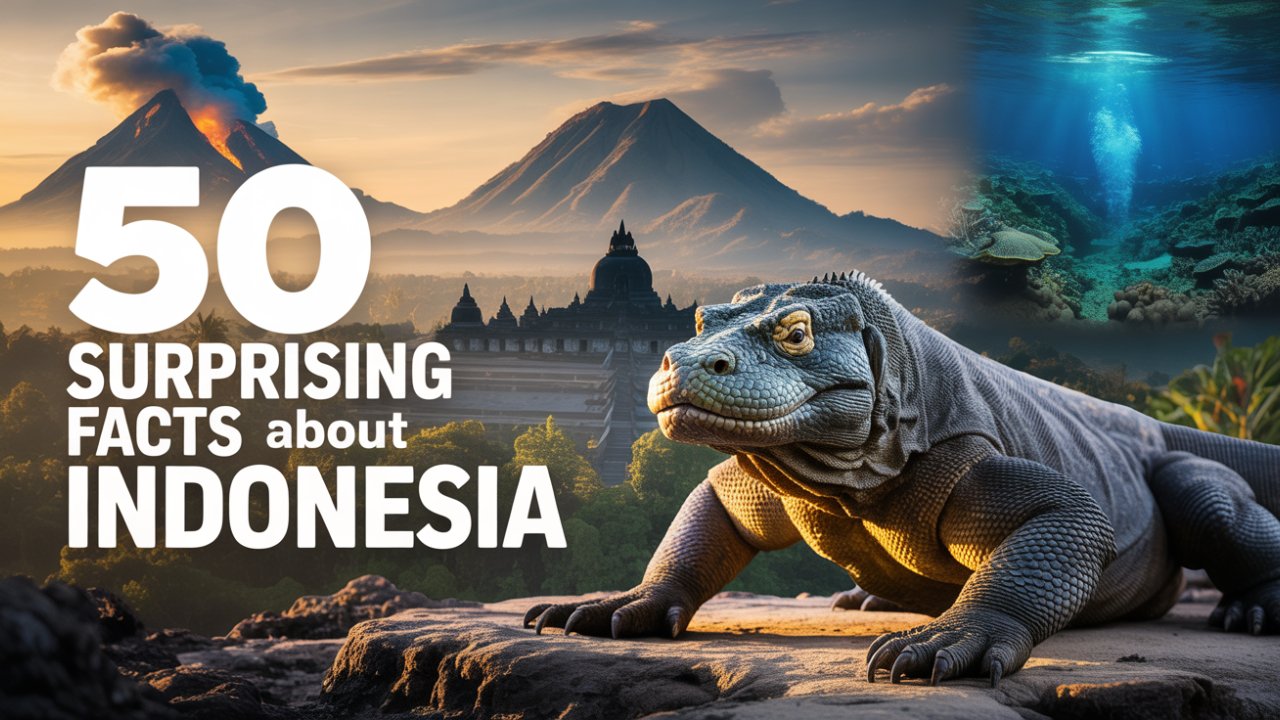When you think of Indonesia, what’s the first thing that comes to mind? Maybe those perfect, emerald-green rice paddies terraced down the hillsides? Or the sun-bleached, white-sand beaches of Bali, where the waves gently kiss the shore? For a lot of people, that’s where the story ends: a beautiful postcard from a corner of paradise. And while it is beautiful, that picture doesn’t even begin to tell the whole story.
What if I told you that hidden behind that postcard is a land of real-life dragons, roaming on ancient islands? A nation that built the world’s largest Buddhist temple but is home to the planet’s largest Muslim population? What if I told you about a flower that smells like death, a capital city that’s sinking into the sea, and a volcano that breathes electric-blue fire?
Get ready, because we’re counting down 50 surprising facts about Indonesia that will challenge everything you thought you knew. This is the side of the country you haven’t seen.
We’ll start our journey in the wild heart of the archipelago, a land of incredible life and geological drama.
First, let’s wrap our heads around the sheer scale of this place. Indonesia isn’t just a country; it’s the world’s largest archipelago. Officially, it has over 17,500 government-recognized and named islands. If you decided to visit one island every single day, it would take you almost 48 years to see them all. And out of all those, only about 6,000 are actually inhabited, leaving thousands of untouched, unexplored pieces of land scattered across the sea.
With all those islands, you get an unbelievable amount of coastline. In fact, Indonesia has the second-longest coastline on the entire planet, stretching for a mind-boggling 99,000 kilometers. Only Canada has more. This immense coastline is a world of its own, featuring everything from black volcanic sands to bustling port cities and some of the most vital coral reef systems on Earth.
You’ve heard of the Amazon, but Indonesia’s rainforests are a global treasure. They are home to the third-largest area of tropical primary forest in the world, right after the Amazon and Africa’s Congo Basin. These forests are essential for the planet’s health, and even though they cover just 1% of the Earth’s land, they are a powerhouse of biodiversity, containing a staggering percentage of the world’s known plant, mammal, and bird species.
Deep inside these forests, you can find things that seem torn from a fantasy novel. Indonesia is home to the world’s largest single flower, the Rafflesia arnoldii, better known as the “corpse lily.” This bizarre parasite has no leaves, roots, or stem. It just erupts from the forest floor as a giant, fleshy bloom that can grow a meter across and weigh up to 10 kilograms. It earns its nickname by smelling like rotting meat to attract the flies that pollinate it.
And if one giant, stinky flower wasn’t enough, Indonesia is also home to the world’s tallest flower, the Titan Arum. This monster can grow over three meters tall. Just like the Rafflesia, it’s also called a “corpse flower” because of the overpowering stench of decay it unleashes to attract pollinators. Imagine taking a walk through a jungle and stumbling upon a ten-foot-tall flower that smells like death welcome to Sumatra.
Now, about those dragons. The legendary Komodo dragon, the largest lizard on Earth, is found nowhere else in the wild except for a few Indonesian islands, like Komodo and Rinca. These are serious predators, growing up to 10 feet long and weighing over 150 pounds. They are the kings of their islands, equipped with a venomous bite that helps them take down prey as large as a water buffalo. Seeing one in person is like stepping back into prehistoric times.
While the dragons steal the show, Indonesia’s biodiversity is off the charts. It’s one of the world’s 17 “megadiverse” nations, which means it holds a huge portion of Earth’s species. It’s a refuge for over 100 endangered animals, including the critically endangered Sumatran Tiger, the Sumatran Rhino, and the Anoa, which is the world’s smallest buffalo. This is a land where evolution truly ran wild.
On the island of Sumatra is the Gunung Leuser National Park, a UNESCO World Heritage site and one of the most important conservation areas in Southeast Asia. What makes it so special? It’s the only place left on Earth where orangutans, tigers, rhinos, and elephants all critically endangered still live together in the wild. And speaking of orangutans, there are actually three distinct species: the Bornean, the Sumatran, and the recently identified Tapanuli orangutan, all native to this region.
Indonesia sits right on the Pacific “Ring of Fire,” a 25,000-mile-long belt of intense earthquakes and volcanic eruptions. This location has blessed and cursed the nation with around 130 active volcanoes, more than almost any other country. These “fire mountains,” as they’re known locally, have shaped the land and the culture for thousands of years.
Among those volcanoes is the legendary Mount Tambora. In 1815, Tambora produced the most powerful volcanic eruption in recorded history. The explosion was so huge it was heard over 2,000 kilometers away. It blasted so much ash into the atmosphere that it caused a “volcanic winter,” leading to 1816 being called the “Year Without a Summer” in the Northern Hemisphere and causing massive crop failures and famine worldwide.
But Indonesia’s volcanoes don’t just bring destruction; they create spectacles of surreal beauty. On the island of Java, the Kawah Ijen volcano is famous for a mesmerizing and eerie phenomenon: electric-blue fire. This isn’t lava. It’s sulfuric gas bursting from cracks in the volcano at high pressure and temperature, which ignites when it hits the air, creating rivers of blue flame that flow down the mountain at night.
The crater of Kawah Ijen also holds the world’s largest highly acidic lake. This kilometer-wide lake is a stunning, otherworldly turquoise, but you definitely don’t want to go for a swim. With a pH level that can dip below 0.5, its water is incredibly acidic, with a corrosive power that rivals battery acid. It’s a beautiful, deadly cauldron forged by nature’s raw power.
Think a tropical country can’t have glaciers? Think again, but be quick. In the province of Papua stands Puncak Jaya, the highest mountain in all of Oceania. Incredibly, despite being near the equator, its peaks have long held glaciers. However, these tropical ice fields have been melting at an alarming rate and, as of 2025, have all but vanished a dramatic and tragic sign of our changing planet.
Volcanic activity also created the world’s largest volcanic lake, Lake Toba, in Sumatra. This enormous body of water, covering over 1,100 square kilometers, fills the caldera of a supervolcano that erupted about 75,000 years ago. That eruption was a climate-changing event, and the peaceful lake that sits there today, with an entire island rising from its center, hides a very violent past.
Deep in the Indonesian archipelago lies Raja Ampat, an area scientists consider the epicenter of marine biodiversity. It’s a key hotspot within the Coral Triangle, a region that’s home to about 76% of the world’s known coral species. The waters here are so rich that many call Raja Ampat a “species factory,” a biological hotspot that helps replenish reefs across the Pacific and Indian Oceans.
Now, let’s peel back the layers of time to explore a culture so diverse it’s hard to imagine, built on ancient empires, deep spiritual traditions, and a powerful sense of identity.
The national motto of Indonesia is “Bhinneka Tunggal Ika,” an Old Javanese phrase meaning “Unity in Diversity.” This isn’t just a catchy slogan; it’s the nation’s guiding philosophy. It comes from a 14th-century poem written to promote harmony between Hindus and Buddhists, and today, it stands for the unity of a nation made of countless different cultures, languages, and beliefs.
So, how diverse are we talking? Indonesia is home to over 1,300 recognized ethnic groups. From the Javanese and Sundanese on the most populous island to the hundreds of distinct groups in the remote valleys of Papua, each has its own unique traditions, art, and way of life.
With that many ethnic groups, you also get a ton of languages. After Papua New Guinea, Indonesia is the second most linguistically diverse country on Earth, with over 700 distinct native languages spoken across its islands. While nearly everyone speaks the official language, Bahasa Indonesia, most people also speak their local mother tongue, creating a deeply multilingual society.
The story of Bahasa Indonesia is fascinating in itself. To avoid making one ethnic group’s language dominant, the nation’s founders chose a standardized form of Malay as the official language. At the time, Javanese was spoken by far more people, but choosing Malay, which was already used for trade across the islands, was a smart move to foster unity and equality.
Let’s talk about Batik, a global icon of Indonesian culture. This isn’t just patterned cloth; it’s an ancient art form. The beautiful designs are made by applying wax to fabric, which resists dye, allowing an artist to create incredibly complex patterns. In 2009, UNESCO officially recognized Indonesian Batik as a Masterpiece of the Oral and Intangible Heritage of Humanity.
Long before Islam and Christianity arrived, the islands were home to powerful Hindu-Buddhist kingdoms, and they left behind a legacy written in stone. In Central Java, you’ll find Borobudur, the world’s largest Buddhist temple. Built in the 9th century, this massive monument is decorated with over 2,600 relief panels and 504 Buddha statues. It’s basically a giant stone textbook on the path to enlightenment.
Just a short drive from Borobudur is Prambanan, a breathtaking complex of Hindu temples dedicated to the gods Brahma, Vishnu, and Shiva. Also built in the 9th century, its towering, intricately carved spires are a masterpiece of architecture. The main temple dedicated to Shiva soars 47 meters into the sky, its walls covered in carvings that tell the epic Hindu story of the Ramayana.
Those epic tales, the Ramayana and the Mahabharata, aren’t just old stories here; they are a living, breathing part of the culture. They form the basis for many of Indonesia’s traditional performing arts, most famously the Wayang Kulit, or shadow puppet theater. In it, a master puppeteer, called a dalang, manipulates carved leather puppets behind a screen, telling stories that have been passed down for a thousand years.
Another profound cultural tradition is found in the highlands of South Sulawesi, among the Toraja people. Here, funeral ceremonies are some of the most complex and elaborate in the world. For the Torajans, a funeral isn’t a somber event but a vibrant, multi-day celebration of life, involving entire communities, music, dancing, and ritual sacrifices to help the deceased on their journey into the afterlife.
In one of the most astonishing Torajan traditions, known as Ma’nene, or “The Ceremony of Cleaning Corpses,” families exhume the bodies of their deceased relatives every few years. They carefully clean the bodies, dress them in new clothes, and even pose for family photos with them before returning them to their tombs. For them, it’s a powerful expression of love, showing that family bonds don’t end with death.
Alright, we’re halfway there, and we’ve already covered sinking cities, blue-fire volcanoes, and real-life dragons. If you’re enjoying this deep dive into Indonesia, do us a favor and hit that like button and subscribe so you don’t miss our next adventure. Now, let’s get back to the countdown.
Indonesia isn’t just a land of ancient history. It’s a dynamic, modern nation with its own strange records, impressive achievements, and fascinating quirks.
The island of Java is a global phenomenon. While it makes up only about 7% of Indonesia’s total land, it’s home to over half of the country’s population that’s around 152 million people. This makes it, by a huge margin, the most populous island on the planet. To put that in perspective, Java has more people than Russia or Japan living on a piece of land roughly the size of England.
Indonesia’s capital, Jakarta, is a megacity facing a huge problem. It holds the unfortunate title of being the fastest-sinking major city in the world. Because of the massive, unregulated extraction of groundwater, parts of North Jakarta have sunk by as much as 2.5 meters in just 10 years. Today, around 40% of the city sits below sea level.
This sinking problem is so bad that Indonesia is actually moving its capital. In 2019, the government announced a plan to relocate the nation’s capital from Jakarta to a brand-new city called Nusantara, being built in East Kalimantan on the island of Borneo. It’s one of the most ambitious and expensive relocation projects in modern history.
Indonesians really love their instant noodles. So much so, that in 2005, the food company Indofood set a Guinness World Record by creating the largest packet of instant noodles ever made. It weighed a whopping 665 kilograms that’s about 8,000 times bigger than a regular packet.
In the world of sports, Indonesia has a surprising place in football history. Competing as the Dutch East Indies, it was the very first Asian country to ever play in the FIFA World Cup, back in the 1938 tournament in France. They were knocked out in the first round, but it was a groundbreaking moment for Asian football.
When it came to connecting its thousands of islands, Indonesia was a pioneer. Back in 1976, it became the first developing country in the world to operate its own domestic satellite system. The satellite, named “Palapa,” was a game-changer, bringing television and telephone services to millions of people for the first time.
The country’s third president, B.J. Habibie, wasn’t just a politician; he was a brilliant aeronautical engineer. He worked for years in Germany, where he developed what’s known as “Habibie’s Crack Progression Theory,” a formula to predict cracks in aircraft materials that helped make planes safer.
One of the most famous and controversial luxury products from Indonesia is Kopi Luwak, often called one of the most expensive coffees in the world. Its strange production method is what makes it famous: coffee cherries are eaten by a small mammal called the Asian palm civet. The beans pass through the animal’s digestive system, where enzymes supposedly make the coffee smoother and less acidic. The beans are then collected from the droppings, cleaned, and roasted.
While many of us start our day with coffee, many Indonesians turn to Jamu, a traditional herbal medicine used for centuries. Made from natural ingredients like turmeric, ginger, roots, and flowers, Jamu is sold everywhere, from street carts to trendy cafes. It’s used for everything from fighting a cold to boosting energy and is a huge part of daily wellness culture.
Just a few hours from the modern chaos of Jakarta lives a community that has almost completely rejected modern life. The Baduy people live in voluntary isolation, shunning technology, formal education, and modern infrastructure. The strictest inner group, the Baduy Dalam, don’t use electricity, vehicles, or even shoes, living a life governed by ancient laws designed to keep them in harmony with nature.
In a fascinating twist, the Outer Baduy, who live as a buffer zone, have started to cautiously interact with the modern world. While sticking to most traditions, some have begun using mobile phones which they often have to charge in neighboring villages and selling their handmade crafts to tourists, creating a complicated dance between ancient tradition and globalization.
Have you ever noticed that Indonesia’s flag looks a bit familiar? The simple red and white flag, known as “Sang Saka Merah Putih,” is almost identical to the flag of Monaco. The only real difference is the ratio; Indonesia’s is slightly wider. It also happens to be the reverse of Poland’s flag.
While Indonesia is the world’s most populous Muslim-majority country, its national laws are not based on Sharia law. The official state philosophy, Pancasila, guarantees religious freedom and officially recognizes six religions: Islam, Protestantism, Catholicism, Hinduism, Buddhism, and Confucianism. The only exception is the province of Aceh, which has special autonomy and does enforce some Sharia bylaws.
Indonesia is the birthplace of a deadly and beautiful martial art known as Pencak Silat. It’s a full-body fighting style using strikes, grappling, and weapons. Its movements are often fluid and dance-like, sometimes mimicking animals like tigers and eagles. In 1948, the various styles were formally unified under the Indonesian Pencak Silat Association, or IPSI, establishing it as a national sport.
On the island of Flores, archaeologists discovered the remains of a tiny, extinct species of human, nicknamed “the Hobbit.” Officially named Homo floresiensis, these people stood only about 3.5 feet tall. They lived on the island until as recently as 50,000 years ago, which means they likely coexisted with modern humans. This discovery completely changed our understanding of human evolution.
Indonesia sits on some of the world’s largest reserves of valuable minerals. The Grasberg Mine in Papua is one of the largest gold and copper mines on the planet. Located in a remote, high-altitude region, the mine is a massive feat of engineering and a huge part of Indonesia’s economy, but also a source of major environmental and social controversy.
Indonesia has a relatively young and dynamic population, with a median age of around 31. This “demographic dividend,” with a huge portion of the population in their prime working years, gives the country massive potential for economic growth and innovation, making it a key player in the future global economy.
Street food is a way of life in Indonesia, and a common sight is the kaki lima, or mobile food cart. The name literally means “five feet.” There’s a popular story that it refers to the cart’s two wheels, a stand, and the vendor’s two feet, but the name most likely comes from old colonial regulations that required sidewalks to be five feet wide.
Indonesia is the world’s fourth most populous country, with over 280 million people, trailing only China, India, and the United States. Its massive and diverse population makes it a cultural and economic powerhouse in Southeast Asia.
Here’s a small cultural tip: you might see people pointing with their thumb instead of their index finger. Using the index finger, especially to point at people, can be seen as rude or aggressive. The thumb is a more polite and respectful way to gesture, a small detail that speaks to a culture that values humility.
Indonesians are among the most active social media users in the world. The country consistently ranks high for activity on platforms like Instagram, TikTok, and X. This digital-first mindset exists right alongside ancient traditions, creating a unique world where a shadow puppet master might also be a viral TikTok creator.
The country is the world’s leader in palm oil production, accounting for more than half of the global supply. This industry has been a major engine for economic growth but has also sparked significant controversy due to its connection to deforestation and the destruction of habitats for endangered species like the orangutan.
Indonesia’s currency, the Rupiah, has a lot of zeroes due to a history of inflation. It’s totally normal to see prices in the hundreds of thousands or even millions for everyday things. Becoming a “millionaire” here is surprisingly easy one hundred US dollars can convert to over 1.5 million Rupiah, which makes first-time visitors feel incredibly rich, at least on paper.
In Balinese culture, there is a unique tooth-filing ceremony called Metatah that marks the passage into adulthood. The ceremony involves filing down the six upper front teeth to symbolically smooth out “animalistic” traits like greed, lust, and anger. It’s seen as a vital spiritual duty for every Balinese Hindu to undergo before they can get married.
And finally, the most unbelievable fact might just be that a place of such mind-blowing diversity with its competing forces of nature, hundreds of cultures, and clashing timelines of ancient and modern can even exist as one, unified nation. From glaciers on the equator to sinking cities, from real-life dragons to people who reject the modern world, Indonesia isn’t just a country; it’s proof that unity can be found in the most staggering diversity. It really is a land of endless surprises.
So there you have it 50 facts that prove Indonesia is one of the most complex, surprising, and fascinating countries on Earth. It’s a place where the impossible feels real, where history, myth, and the daily news all blur into one incredible story.
What was the most unbelievable fact for you? Was it the blue-fire volcano? The corpse-cleaning ceremonies? Or maybe the world’s most crowded island? Let us know in the comments below. We read every single one and would love to hear what blew your mind.
And if you have an idea for another country you want us to cover, drop that in the comments too. Thanks for watching, and we’ll see you on the next journey.





